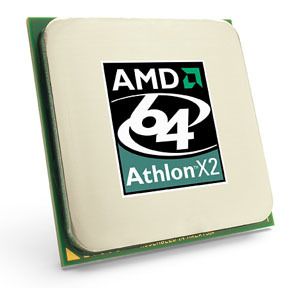AMD challenges Intel with 35W, 65W desktop processors
Sunnyvale (CA) - Performance-per-watt is the name of the game in today's microprocessor market: Intel will be launching a new architecture in the third quarter of this year to cut power consumption of its processors in half, while AMD apparently has still enough potential in its current chips to answer - and actually surpass Intel's power numbers.
Since the early days of the microprocessor industry, power consumption never has been considered to be a real concern and consistently has been inching up to the record levels we have today. However, a growing trend towards mobile computing and small form factor PCs prompted especially processor manufacturers to rethink its path and come up with more power-efficient CPUs across the board.
While we already have energy-saving chips for mobile computers and we do not expect the very high-end of desktop processors to drop very much from its 110W (AMD) and 130W (Intel) level in the near future, mainstream desktop computers will soon consume substantially less power than they do today. It was Intel that initially revealed a 65W target for its next-generation mainstream desktop processors, formerly code-named Conroe and to be launched as Core 2 Duo E4000 and E6000 series in the third quarter of this year. However, it is AMD that is first to actually offer processors that drop their thermal design power (TDP) from 110W/89W to 65W.

The company will offer 65W versions of the dual-core Athlon 64 X2 4800+, 4600+, 4400+, 4200+, 4000+ and 3800+. David Schwarzbach, marketing manager in AMD's desktop division, said that the processors will provide exact the performance of their 110W/89W counterparts and will be available in retail stores in May for a premium of about 5% over their more power hungry sister models.
If 65W is not enough, AMD is also offering "small form factor desktop processors." A version of the dual-core Athlon 64 X2 3800+ as well as a single-core Athlon 64 3500+ and Sempron 3400+, 3200+ and 3000+ are rated at a TDP of just 35W, which is exactly the rating of AMD's mobile Turion 64 MT processors. Intel will not be able to match this level with its Core 2 Duo with Conroe core. However, we would expect Intel to answer AMD challenge with Core 2 Duos equipped with the mobile "Merom" core, which should be hitting a TDP a range of 25 to 30W, according to sources.
For now, AMD will be offering the 110W and 89W CPUs side-to-side with the newer 65W and 35W processors, which are based on the new AM2 socket. It's obvious that AMD will leverage the power-benefit as an argument to charge more money for the new processors, but Schwarzbach suggested that it could also be a "yield issue" and a strategy to maximize fab efficiency while AMD continues to offer the "old" socket 939-based Athlons. Consumers will be able to identify the more power-efficient processors through specially marked retail boxes, Schwarzbach told TG Daily.
Pricing of the new 35W processors begins at $101 for the Sempron 3000+ and reaches $364 for the Athlon 64 X2 3800+. The 65W dual-core processors pricelist starts $323 for the 3800+ model and ends at $671 for the 4800+ version.
Stay on the Cutting Edge
Join the experts who read Tom's Hardware for the inside track on enthusiast PC tech news — and have for over 25 years. We'll send breaking news and in-depth reviews of CPUs, GPUs, AI, maker hardware and more straight to your inbox.
Most Popular

